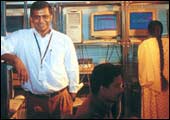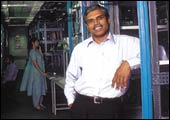 |
| Mani Kantipudi, Director,
IIDC: Helping Intel become an e-corp |
Founded: 1999
Number of Employees: 900
Investments thus far:
Rs 120 crore
IP: 34 Invention Disclosures and
8 Patent Filings |
INTEL
India Inside
Over a 100 million computers the world over
bear testimony to the contribution of the Bangalore-based Intel
India Development Center.
Three fleeting
seconds of digital squiggles on a computer screen could probably
sum up the contribution of Intel India Development Center better
than many reams of text. The display, called bios by those in the
know, and the text that appears between the time a user switches
on his pc and the familiar Windows logo appears by those not, was
developed in India (and has been installed in over 100 million PCs).
The swank six-storeyed glass-and-chrome structure
in Bangalore's busy Airport Road is immune to the slash-and-burn
evident in the rest of Intel's operations, a 4,000-reduction in
workforce. Instead, Mani Kantipudi, the young-looking 35-year-old
Director of IIDC, is considering hiring more for the 900-strong
facility. "We believe the technical talent available here could
be effectively leveraged to drive Intel's growth."
Some of IIDC's efforts go into ensuring that
Intel meets its target of becoming an e-Corporation by 2004. These
range from procurement and inventory management systems for Intel's
chip fabrication plants to networking protocols for the company's
vast operations (it is present in 45 countries). Kantipudi is loath
to put a number to such work but admits that, "these systems
have given a net benefit of hundreds of millions of dollars for
Intel."
Outside Intel, IIDC is involved in the design
of the next generation of Intel routers (yes, the company makes
them, and it is a multi-million dollar business for it worldwide)
and is the only Intel-facility in the world doing so. So, there.
-Venkatesha Babu
HP
Silicon Alley
The original garage start-up HP's Indian R&D
facility is its second-largest after the one in San Jose.
 |
|
Gautham Natanasabapathy, VP, HP-ISO: Driving high-end
research
|
Founded:
1989
Number of Employees: 1000
Investments thus far: Rs 288 crore
IP: 3 patents, 38 patent filings,
and 108 invention disclosures since inception of which 3, 21,
and 61 respectively have been in the past 30 months. |
The HP printer
on your desk may well have been designed in the company's r&d
facility (called hp India Software Operations) in Bangalore. "We
conceive, architect, and release products out of Bangalore,"
says Gautham Natanasabapathy, Vice President, HP-ISO. In terms of
both size and importance, the Bangalore facility is second only
to the company's central nervous system, its San Jose HQ. Almost
a third of the work that goes into the HP version of Unix (HP-UX),
which runs on high-end servers is done out of India as is a fifth
of the R&D effort that goes into the company's Storage and Openview
software. Natanasabapathy figures ISO must have helped the company
save some $40 million (Rs 192 crore) in the past year alone and
in just these three categories. As for the work, it's as high-end
as can get: among the ISO's achievements are a utility to manage
distributed security on Unix networks, and a Service Location Protocol,
a method of organising and locating resources on a network in such
a way that maintenance of existing devices on the network and the
addition of new ones can be achieved without reconfiguring individual
workstations. "Our belief in India is summed up in the fact
that the HP India research facility is the second-largest one after
the one in San Jose," says Natanasabapathy.
-Venkatesha Babu
GE
Jack's Legacy
Some of GE's finest R&D work is happening
at the John F. Welch Technology Research Center in Bangalore.
 |
|
Guillermo Wille, MD, John F. Welch Technology Research
Centre: Leading GE's R&D thrust in India
|
Founded:
2000
Number of Employees: 1,600
Investments thus far: Rs 384 crore
IP: 17 patent filings |
There's an air
of mystery around the John F. Welch Technology Research Center in
Whitefield, an industrial township on the outskirts of booming Bangalore.
The company is, in part, responsible for this. Security is tight,
and a giant incinerator located on the premises ensures that even
the waste doesn't tell tales. Don't let the sense of mystery cloud
your senses. Some of GE's bleeding-EGDE work is done out of this
35-acre spread, the company's second largest research facility after
the one at Schenectady. From nanotechnology to biotechnology to
photonics to advanced propulsion systems, anything is fair game
for the centre.
The JFWTRC has already started making its presence
felt within the conglomerate. It has helped GE Medical Systems develop
an MRI machine that can help doctors see blood vessels hidden behind
bones, something traditional MRI machines couldn't do. The secret:
a computer aided visualisation technique patented by the centre.
If that's too esoteric, here's a taste of the more mundane: JFWTRC
has helped the company's consumer durables arm reduce dishwasher
noise levels significantly by using water splash acoustics. Other
breakthroughs include Lexan, a plastic that goes into making safer
cars and materials that can create better optical and magnetic media.
Phew!
The centre hasn't been awarded any patents
yet, but Guillermo Wille, its Managing Director, believes it is
only a matter of time before that happens. "We have filed for
17 patents in areas as diverse as chemistry, engineering systems,
medical imaging, and electronics." "Given the potential
here, we see this trend accelerating." Only, the company is
unlikely to make much noise about that.
-Venkatesha Babu
CISCO
The Silk Route(r)
It doesn't design routers yet, but Cisco's R&D
facility in India does almost everything else.
 |
|
S. Devarajan, VP & Head, IGDC: Cisco's India play
is long-term
|
Founded:
2000
Number of Employees: 700
Investments thus far: Rs 252 crore
IP: 30 patent filings |
Cisco didn't really
need a development centre in India. After all, India's finest software
companies such as Infosys, Wipro, and HCL Technologies had dedicated
resources working on projects for the company that can claim to
run the internet. Still, the San Jose, California-based router major
persisted, established its India Global Development Center (IGDC)
in 2000. Today, the centre has 700 employees, has filed for 30 patents,
and focuses on core research areas relevant to the networking company.
"The India play itself is a strategy for Cisco," explains
S. Devarajan, Vice President and Head, IGDC. "We want to effectively
utilise the kind of technical talent available in the country."
As for a made-in-India router, Devarajan admits it may be some time
away, but (why aren't we surprised) doesn't rule it out.
-Venkatesha Babu
IBM
Big Bloom
One of the five IBM research labs outside the
US, the India one is working on areas as diverse as bio-informatics
and e-governance.
 |
|
Manoj Kumar, Director, IBM Research Labs: The USP
is fundamental research
|
Founded:
1998
Number of Employees: 75
Investments thus far: Rs 50 crore+
IP: 5 patents awarded in 2001 |
You can't find
a better place for a research lab. IBM's is located within the sprawling
320-acre campus of the Indian Institute of Technology, Delhi. The
lab's objective-to bring innovation to the IBM product line-may
seem mundane, not the areas it is focussing on: electronic commerce,
e-governance, computational biology, weather forecasting, and technologies
that can improve human-computer interaction. Dr Manoj Kumar, Director,
IBM Research Labs, believes his facility is perhaps the only one
"involved in fundamental research". "We don't even
know what our efforts will lead to (in terms of end-products),"
he laughs. The research itself is no laughing matter. A significant
portion of IRL's efforts is focussed on helping online marketers
target their customers more effectively. The other big initiative
at IRL is knowledge management, an effort to help companies organise
information in such a manner as to facilitate its retrieval automatically,
intelligently, and with a provision for customisation. Then, there's
an effort to develop software that can assist genetic research.
And another to facilitate the automatic translation of text from
one language to another (Machine Translation). Today, there are
10 projects in these areas, and a few others on at IRL. "Each
of these areas are promising," explains Kumar. "I often
wonder how many (of the projects) will have a major impact; I hope
most do."
It helps that the parent is focussed on core
research. In 2001, IBM was awarded the most number of patents (3,411)
by the US Patent and Trademark Office. And the total number of patents
held by Big Blue exceeds the aggregate of those awarded to hp, Intel,
Compaq, Sun, Microsoft, Dell, Apple, EMC, Oracle, Accenture, EDs,
and AOL. Last year, the company spent more than $5.6 billion (Rs
27,274.24 crore) on research worldwide.
IRC's own achievements-five patents awarded
in 2001-may seem insignificant in comparison to this formidable
array of statistics. Still, some of the five deal with bleeding
edge applications like collaborative computing and parallel processing.
It looks good.
-Vinod Mahanta
|

